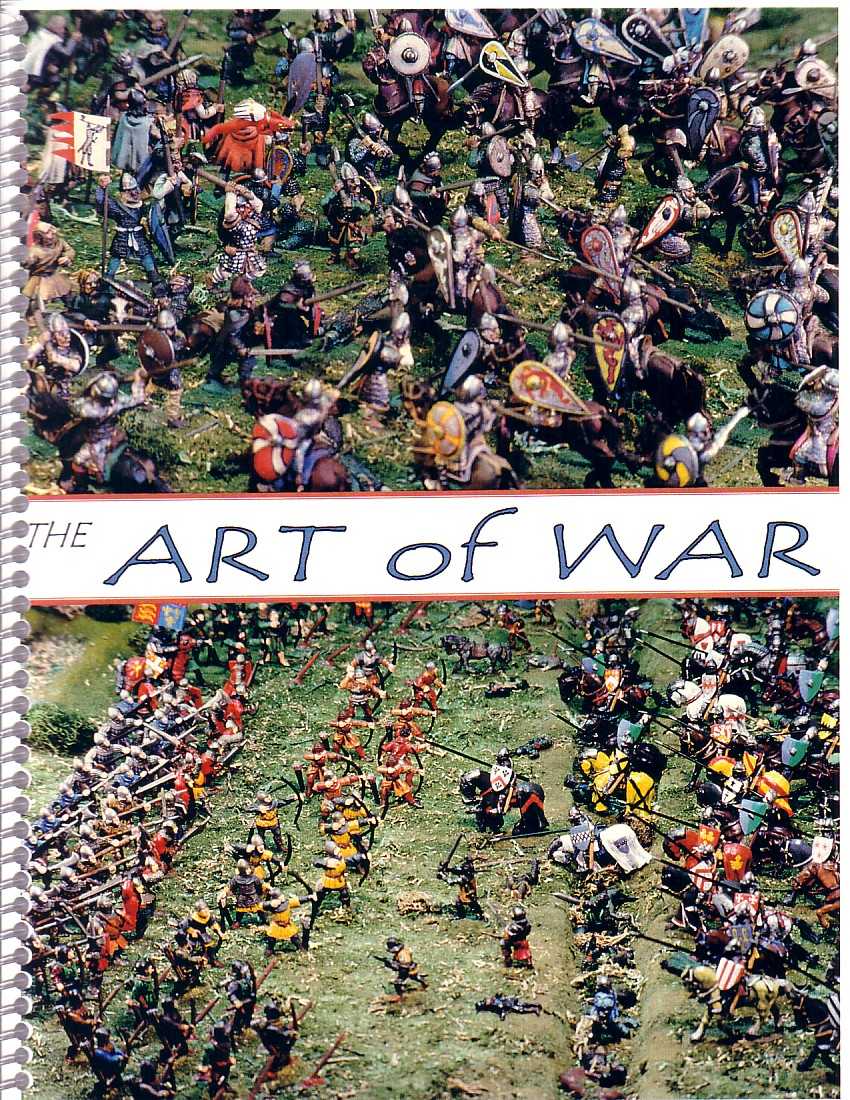|
|
||||||||||
 |
|
The Rules Directory only works if you help. Write a review. Get the review template here. |
|
TITLE (YEAR): The Art of War, Tactical Warfare in Miniature for Pre-Gunpowder Armies (1984 to 2008) AUTHOR: Doug Larsen and Rocky Russo PUBLISHER: Doug Larsen and Rocky Russo. PUBLICATION DATE:2008 WEB SITE/SUPPORT FORUM:
PRICE (with date):$10.00 e-book version (PDF format); $35.00 hardcopy version. (2008) REVIEWED BY:Doug Larsen PERIOD COVERED:
THE BOOK: Basic rules, plus a Crusades mini-campaign appendix including 9 armies lists: 62 pages. The Basic Rules are comprehensive, and include siege warfare rules and rules for special weapons such as elephants, chariots and pavises. Spiral bind, photocopy, black and white interior, full color cover. Standard 15mm to 40mm frontages used: no rebasing of figurines required. (Although singly-based miniatures work best, multiple-figurine bases work OK in most situations.) Plus 84 additional pages of seven period appendices listing over 160 more armies:
SCOPE: The Art of War is a battlefield level game with each base representing a "company" of men (and horses), ranging in size from 30 to 100 men each. The approach of the game design is to allow play of historical battles on the scale historical terrain. ARMY SIZE:
BASE UNIT:
GAME SCALES:
BASING SIZES: 15mm to 30mm frontages; 20mm to 25mm depth for infantry, 40mm to 50mm depth for cavalry. Depth can be increased for larger models. TURN SEQUENCE:
GAME MECHANICS: Command and Control: is regulated by both minimum-allowed unit size and total number of units allowed a given army. Morale: is tested for each unit that takes 25% casualties; for seeing other friendly units rout; for receiving a cavalry or chariot charge (or some phalanx charges), etc. There are exceptions outlined in each army list. Individual bases are also required to test morale in close combat when the result so indicates. Fire Combat: missile fire is performed by rolling 2d6 for each shooting base; the missile fire tables indicate which number or better is needed to score a "hit" on a target of a given armor rating and at a given range. The shooting base scores as many hits on the enemy unit being targetted as the total men shooting: ex. three 60-men bases scoring hits causes 180 casualties on the targetted unit; and casualties are removed in whole bases, with any remainder rounded up to the next whole base. (A full description of how this works would be required, so a shortened version is not given here.) Close Combat: is resolved base-to-base with 2d6; the base with the highest combined combat value is defined as the "Attacker". Results are compared on the combat results table, and the combat is either "no effect", or a Defender or Attacker base is pushed back or eliminated; some "back" results also require a morale test immediately on the pushed back base. ARMY LISTS/SCENARIOS: as described above, there are 9 army lists in the Crusader appendix and over 160 additional more in the historical period appendices. REVIEWER’S COMMENTS: As coauthor and codesigner, my opinion is naturally biased. But neither Rocky Russo or myself enjoys much playing of rules designed by other people; the reasons are two: we feel we understand more and better (at least to our mutual satisfaction), what the armies in the periods covered were capable of and how they worked; and we prefer our "skirmish feel" game design to the multiple basing and abstract rules so frequently employed by other game systems. We design rules to directly replicate reality as much as seems possible for a game. Our game plays to reflect the weapons systems and tactics as revealed by historical evidence and the original sources. For instance, we throw pila, charge with couched lances, differentiate between single stave self-bows and composite "Steppes" bows, and consider the tactical differences that weapon systems combined with the level of drill and organization allow a given army. We like quick and bloody games, and we like to see our miniatures "perform" as the individual "men" that they appear to be in the battle, while at the same time realizing that each miniature is really a company of men that it represents the typical appearance of. PLAYER’S COMMENTS: The game's combat and movement tables are on one side of a single 8.5 x 11 inch sheet. Complexity is designed into what the armies can do and cannot do. Actual play is simple and very quick, facilitated by the lack of abstraction. The game visually shows what is going on (as much as possible, considering the "medium" of playing with miniatures), minimizing the need to interpret unseen factors into what is displayed turn-by-turn on the table top. |
|
[Home] [15mm World] [Reviews Home] [How To] [Beginners Guide] [Gamer's World] [Spanner & The Yank] [Points of View] [The Annex] [Links] [Say Howdy] [Corporate Schill] [Rules Directory] |
 |
